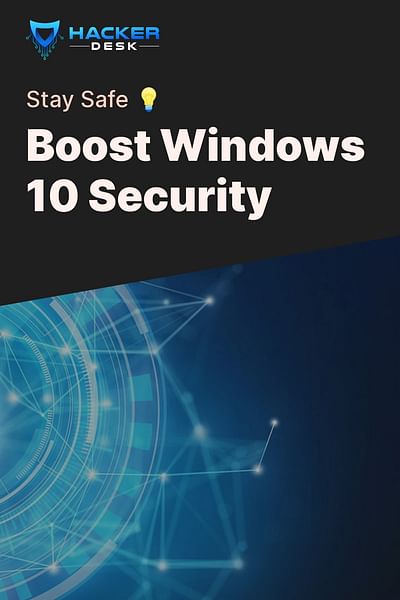Rhett Rowe is a seasoned expert in cybersecurity, boasting over 15 years of professional experience in the industry. He has collaborated with numerous Fortune 500 companies, aiding them in fortifying their digital infrastructures. Rhett is a Certified Ethical Hacker (CEH) and has earned his Master's degree in Information Security from Stanford University.
Hey there! I understand that keeping your Windows 10 secure is a top priority for you. While regular updates are crucial for maintaining the security of your operating system, I also understand that there may be situations where you might not be able to install updates immediately. So, let's explore some alternative ways to enhance the security of your Windows 10 system without relying solely on updates.
1. Use a Reliable Antivirus Software:
Installing a reputable antivirus software is essential for protecting your Windows 10 system from malware and other security threats. Make sure to choose a well-known antivirus solution that provides real-time scanning, firewall protection, and regular virus definition updates.
2. Enable Windows Defender:
Windows 10 comes with a built-in antivirus program called Windows Defender. Ensure that it is enabled and up to date. Windows Defender provides a baseline level of protection against common threats and can help safeguard your system until you can install the latest updates.
3. Employ a Robust Firewall:
Activate the Windows Firewall or consider using a third-party firewall solution to monitor and control incoming and outgoing network traffic. A firewall acts as a barrier between your system and potential threats, helping to prevent unauthorized access and data breaches.
Comparison of Windows Firewall and Third-Party Firewall Solutions
| Features | Windows Firewall | Third-Party Firewall Solutions | Benefits |
|---|---|---|---|
| Inbound and Outbound Traffic Control | Yes | Yes | Monitors and controls incoming and outgoing network traffic |
| Customizable Rules | Limited | Yes | Allows user to set specific rules for different network scenarios |
| Intrusion Detection System (IDS) | No | Yes | Detects suspicious activity and alerts the user |
| Virtual Private Network (VPN) Support | No | Yes | Provides additional layer of security when browsing the internet |
| Ease of Use | High | Varies | Depends on the user interface of the firewall solution |
| Cost | Free | Varies (Free to Premium) | Depends on the specific third-party firewall solution |
4. Regularly Back Up Your Data:
Creating regular backups of your important files and data is crucial. In the event of a security breach or system failure, having backups ensures that you can restore your data and minimize potential damage. Utilize external hard drives, cloud storage, or dedicated backup software to automate the backup process.
5. Be Cautious of Downloads and Email Attachments:
Exercise caution when downloading files or opening email attachments, especially from unknown sources. Malicious software can often be disguised as legitimate files, so it's important to be vigilant and only download files from trusted sources.
6. Practice Safe Browsing Habits:
Adopt safe browsing practices to minimize the risk of malware infections. Avoid clicking on suspicious links, visiting untrustworthy websites, or downloading software from unverified sources. Additionally, consider using a secure web browser that offers built-in protection against phishing attempts and malicious websites.
7. Regularly Perform Penetration Testing:
Penetration testing, also known as ethical hacking, involves simulating real-world cyber attacks to identify vulnerabilities in your system. By conducting regular penetration tests, you can proactively identify and address security weaknesses, even without the latest updates.
Remember, while these measures can help enhance the security of your Windows 10 system without updates, it's crucial to prioritize installing updates as soon as possible. Updates often include critical security patches that address known vulnerabilities, so keeping your system up to date is essential for long-term security.
Stay safe and secure in the digital world!
Ethan Cipher















